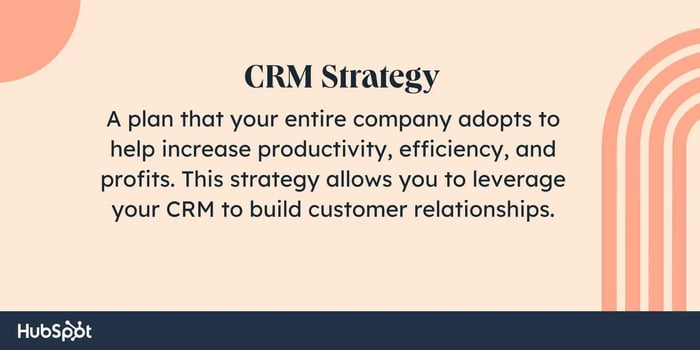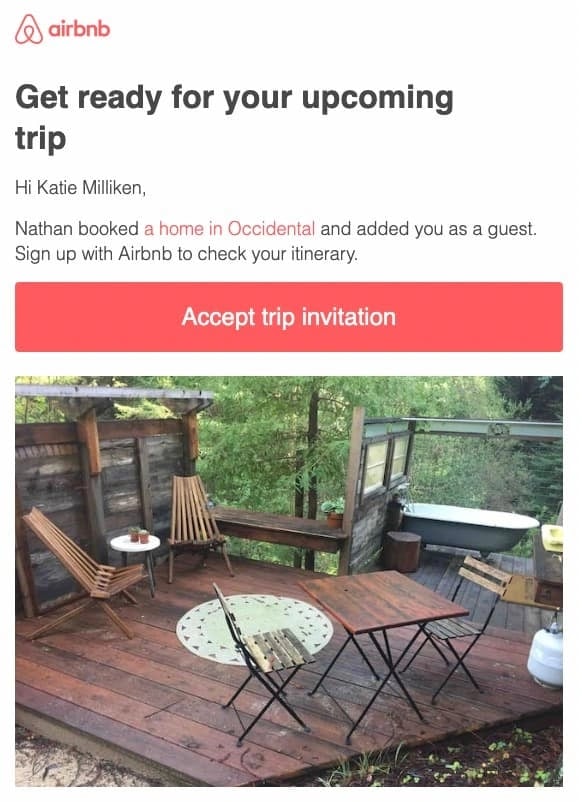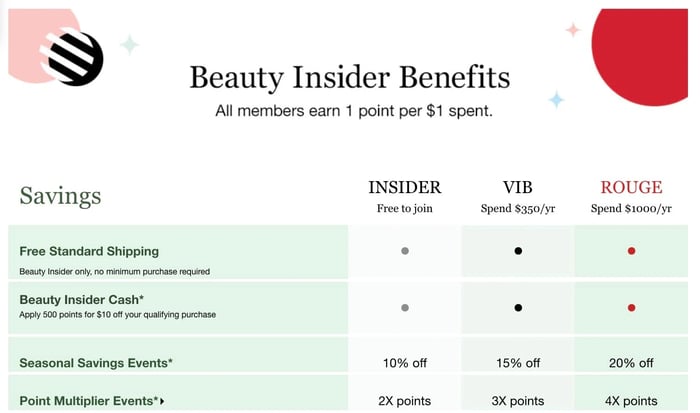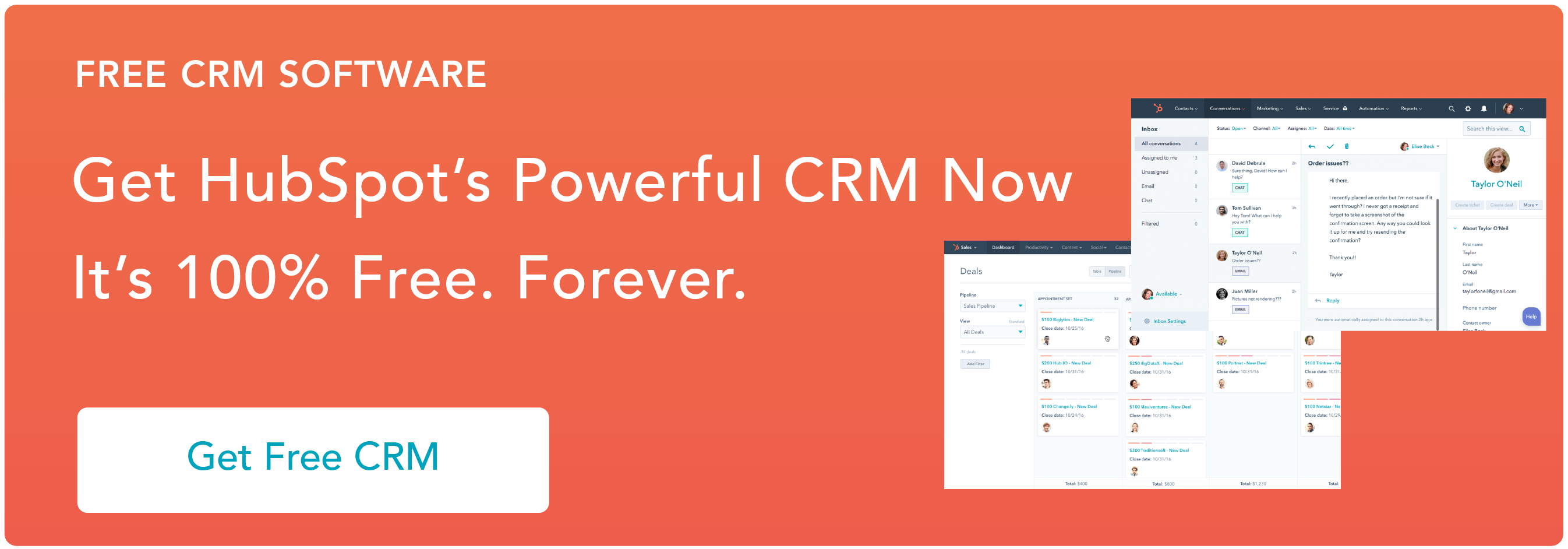How do you develop a CRM strategy?
6 Steps To Create a CRM Strategy
3 Examples of CRM Strategies That Work
A Refresher on CRMs
A CRM is a customizable technology that allows you to keep track of all of your customers’ interactions with your business, from the first time they visit your website to the last time they made a purchase.
CRMs include details like customer contact information, their buying preferences, and notes from every conversation you’ve had with them.
You can tailor the information you enter and retain it in your CRM however you’d like. You should collect as little or as much information as will help you serve your customers and convert prospects more efficiently.
Customer relationship management is just that…managing relationships with your customers. You’ll see a variety of benefits in your business once you incorporate a CRM. These include the following.
1. Happier Customers
A CRM stores a customer or prospect’s digital interactions with your company. It can see the blogs they read, the emails they opened, and the pages on the website where they lingered.
This allows messaging and offers to be tailored to the customer. Customers receive information regarding products they actually need and aren’t bothered with what they don’t.
2. Higher Productivity
Every moment your salesforce spends on administrative tasks is time away from prospects. With automated tasks like call and activity reporting, your salespeople can spend more time doing what they do best.
Plus, they can set notifications as to when they need to follow up with prospects. They can also view notes with personal information they gathered during an interaction, so they can personalize the next conversation.
3. Increased Teamwork
Perhaps your salespeople don’t work alone. Maybe you have a sales development rep (SDR) who spends their days prospecting and qualifying leads before passing them along to an account executive (AE).
This tool improves communication and allows the handoff to be streamlined and efficient. It also helps when you’ve got a salesperson on vacation and a team member needs to follow up on a lead.
4. Hard Numbers
Need to know how your salespeople are doing? You’ll receive data on their conversion rates, average deal size, time to close, and much more.
As you grow and take on more prospects and customers, a CRM can be your lifeline. But only if you use it right.
What is a CRM strategy?

Let’s say that you wanted to hang a picture in your living room. You take a nail and line it up on the wall. Then, you grab a hammer and whack at the nail with the handle while you hold the head of the hammer.
You wouldn’t be hanging any pictures that way. Chances are, you’d have to repair the drywall to boot. Even worse, what if you have a hammer but leave it in the toolbox and just hit the nail with your hand?
You’ve got the right tool, so why isn’t it working? Because you aren’t using it properly (or at all). Without a strategy, no tool in the world will be right for the job you need to do. The same goes for a CRM.
So, what is a CRM strategy?
A CRM strategy is a plan that your entire company adopts to help increase productivity, efficiency, and profits. It’s an organization-wide belief that customers are the lifeblood of your business. Building relationships with them and nurturing those relationships is the fastest path to success.
Ideally, you’ll develop this strategy prior to purchasing your CRM software. This will allow you to choose the tools, capabilities, and price point that’s best for your business.
Without a strategy, your employees may become overwhelmed by all the possible functions and fail to use your new tool at all.
How do you develop a CRM strategy?
A CRM strategy has everything to do with your company and your needs. The strategy (just like the tool itself) is not a one-size-fits-all solution. That’s why it’s so important to take your time developing a CRM strategy.
Before you get started, you’ll need to determine three things:
- What are you hoping to accomplish? What goals have you set for the company? What do you want to get out of your CRM?
- Who are your customers? What does your ideal customer look like and how do you reach them?
- What does their buyer journey look like? In this day and age, customers can interact with your company in multiple ways. You’ll likely have different buyer journeys depending on the type of customer you’re working with.
6 Steps To Create a CRM Strategy
You’ve done the work and have a better understanding of your company, your customers, and your needs. Now, you’re ready to develop your strategy.
While the specific needs of every brand and business will differ, the following six steps can get your CRM strategy off on the right foot.
1. Onboard your employees.
Even the best CRM solutions won’t deliver on their potential if staff aren’t on board with the change.
Help your employees understand why they’re using a CRM and the benefits for them and their customers. When they grasp how much easier it will make their jobs and how much more successful they can be, they’ll be eager to use it.
Best bet? Start with a trial run. Bring in the new tool and let staff explore how it works, what it offers, and how it will change current processes. This last point is the most critical — process familiarity plays a large role in determining which tools are used and how. By giving staff time to understand the new solution, you can set yourself up for strategic success.
It’s also worth getting their feedback on where the system excels and how it could be made better.
2. Provide the proper training.
Next up is training. This is important no matter the type of CRM you implement — even simple, easy-to-use solutions may not naturally integrate with existing processes.
Giving staff the knowledge they need to make the best use of your new CRM is a critical part of the long-term strategy.
3. Establish your brand voice.
The CRM platform can be used to communicate with customers. You can customize email messaging and other content from the beginning of the prospect’s journey all the way through the customer’s lifecycle.
That’s why it’s so important to decide early on what your tone and communication style will be. Are you casual or formal? Humorous or straightlaced? Determine this at the beginning and make sure that every employee understands the expectation.
4. Identify your KPIs.
You need to clearly define your key performance indicators (KPIs) and then communicate them clearly to your team. This ensures that everyone knows what’s being tracked and how it will factor into their performance assessments.
For example, your priority might be generating new customer leads over a specific period of time. Data from CRM tools can provide insight into how many leads teams currently have. Then each month, managers can reassess this data to determine overall trends.
If the number of leads is going up, sales prospecting processes are working. If numbers are trending down, changes may be required.
5. Decide who is doing what.
With any team, responsibilities must be clearly assigned so no one thinks someone else is handling them. Figure out who will own what roles within the CRM system and then communicate them clearly to the individuals involved.
In practice, this could mean assigning members of your IT team the responsibility for maintenance and management of CRM tools in your network, along with designating backup support if these individuals leave the company.
You can also assign different roles, such as data input or analytics, to specific staff members to ensure work isn’t duplicated.
6. Conduct regular reviews.
Your CRM strategy isn’t static. Instead, it needs to change over time as sales volumes grow and customer expectations change. By setting a regular review schedule, typically every 4-6 months, you can assess how current strategies are performing and if changes are required.
3 Examples of CRM Strategies That Work
Remember, there is no cookie-cutter CRM strategy that will work for every business. However, there is a world of CRM strategy examples out there you can learn from and be inspired by.
Do a bit of digging and you may find a company in a similar industry, but perhaps a different market, you can emulate. Or, you may find an entirely different business out there whose strategy can be tailored to fit your needs.
Let’s take a look at three examples.
Airbnb saves with automation.
Customers are assisted through automated communications during their buying cycle which limits the contact between employees and customers to streamline the experience. In most situations, no employee–traveler interaction is necessary.

It uses its CRM to:
- Suggest comparable accommodations in the area by email when a customer is searching.
- Retarget the customer through Facebook ads.
- Send notifications through email, SMS, and the app during the reservation process.
- Email the customer once the reservation is made to encourage them to become an Airbnb host and rent out their own home while they’re away.
- Send a survey after their trip to evaluate the accommodations.
This automation frees up employees to focus on building brand awareness and strengthening the Airbnb community.
Why this works: Automation reduces the risk of incorrect or duplicate data in your system. This both increases accuracy and reduces the amount of manual effort required.
Sephora creates community, inspires loyal customers, and sells them what they actually want.
While many companies have created loyal followers, no one does it quite like Sephora.
- Sephora takes the time to get to know its customers and then uses its CRM to track this information. This allows the brand to segment its customers into different groups and target them with personalized offers.
- The company fosters an online community, allowing customers to interact with both the company and fellow beauty enthusiasts.
- Sephora then encourages customer engagement and purchases with a tiered loyalty program. It rewards its most loyal customers with personalized gifts, offers, and discounts. With three levels, it has created excitement and exclusivity around its loyalty program which helps to boost sales and retain customers.
And it couldn’t do any of it without its CRM.

Why this works: Using CRM data to understand what customers want makes it possible to both improve customer lifetime value (CLV) and understand emerging sales trends.
Wells Fargo manages customer feedback.
With so many ways to contact the company, Wells Fargo uses its CRM to respond quickly to comments and complaints and then logs the conversations in the customer’s record. For example, when a customer comments on one of the company’s social media accounts, a customer service agent is notified and can formulate a response in real time.
Their CRM connects platforms to streamline communication and provide better customer service.
Why this works: Connecting multiple touchpoints via CRM provides a way to gain total customer visibility. This reduces frustration since customers don’t need to explain their issue over and over to agents. You can then reduce the amount of time customers are kept waiting for service.
Strategically Speaking
CRM tools offer a way to move from sticky notes to comprehensive customer data storage, in turn making it easier to find the information you need to keep customers happy.
But making the best use of these tools requires the right CRM strategy. Simply implementing a CRM and hoping for the best may provide initial benefits, but these will taper off over time unless CRM deployments are backed by the right strategy.
Thankfully, the process isn’t complicated. First, onboard employees and then provide them with proper training. Next, establish your brand voice and select your KPIs. Finally, assign responsibility for tasks and regularly review your CRM strategy to ensure it’s keeping pace with customer expectations.
Using a CRM




.jpg)
